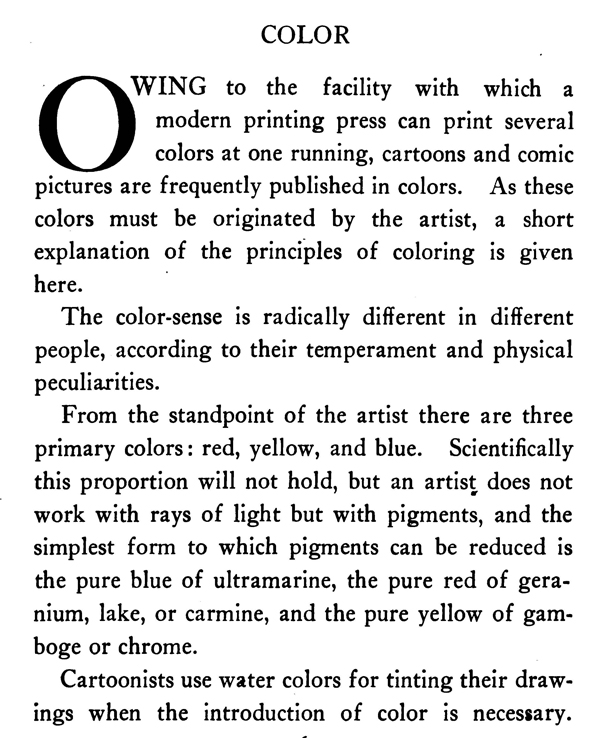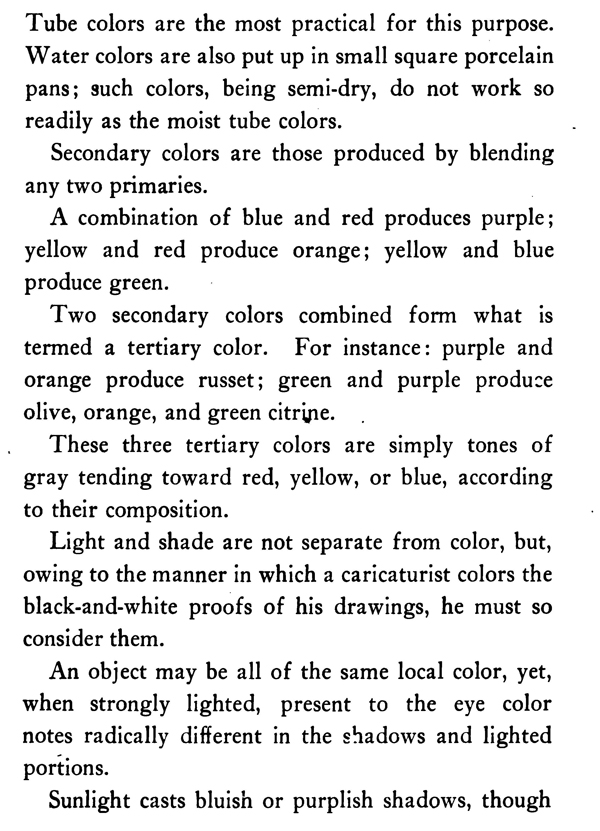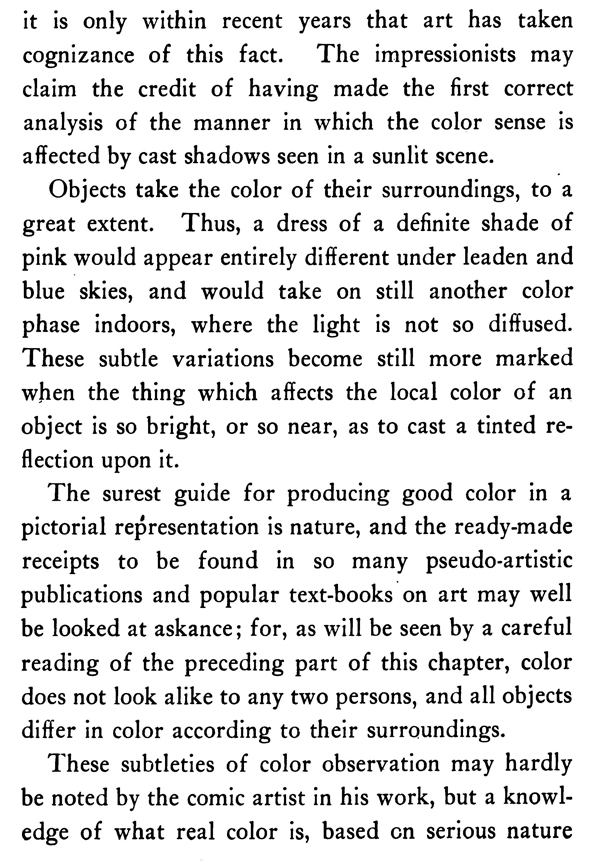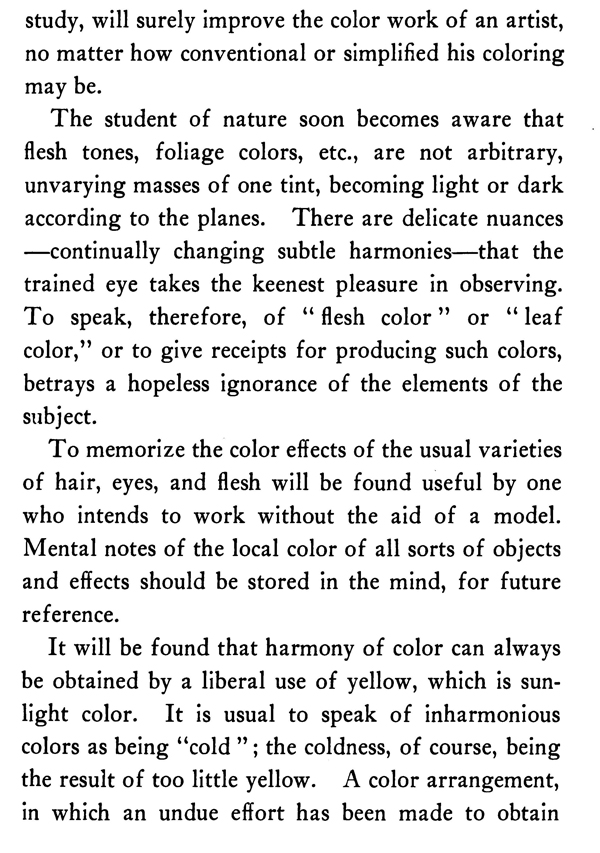Home > Directory Home > Drawing Lessons > How to Draw Caricatures & Cartoon Faces > How to Colorize Caricatures & Color Combinations Usage
HOW TO COLORIZE CARICATURES, CARTOONS & COMIC STRIPS WITH COLOR COMBINATION KNOWLEDGE
|





GO BACK TO THE HOME PAGE FOR CARICATURE DRAWING TUTORIALS
[The above words are pictures of text, below is the actual text if you need to copy a paragraph or two]
COLOR
Cartoons and comic pictures are frequently published in colors. As these colors must be originated by the artist, a short explanation of the principles of coloring is given here.The color-sense is radically different in different people, according to their temperament and physical peculiarities.
From the standpoint of the artist there are three primary colors : red, yellow, and blue. Scientifically this proportion will not hold, but an artist does not work with rays of light but with pigments, and the simplest form to which pigments can be reduced is the pure blue of ultramarine, the pure red of geranium, lake, or carmine, and the pure yellow of gamboge or chrome. Cartoonists use water colors for tinting their drawings when the introduction of color is necessary.
Tube colors are the most practical for this purpose. Water colors are also put up in small square porcelain pans; such colors, being semi-dry, do not work so readily as the moist tube colors.
Secondary colors are those produced by blending any two primaries.
A combination of blue and red produces purple; yellow and red produce orange; yellow and blue produce green.
Two secondary colors combined form what is termed a tertiary color. For instance : purple and orange produce russet; green and purple produce olive, orange, and green citripe.
These three tertiary colors are simply tones of gray tending toward red, yellow, or blue, according to their composition. Light and shade are not separate from color, but, owing to the manner in which a caricaturist colors the black-and-white proofs of his drawings, he must so consider them.
An object may be all of the same local color, yet, when strongly lighted, present to the eye color notes radically different in the shadows and lighted portions.
Sunlight casts bluish or purplish shadows, though it is only within recent years that art has taken cognizance of this fact. The impressionists may claim the credit of having made the first correct analysis of the manner in which the color sense is affected by cast shadows seen in a sunlit scene.
Objects take the color of their surroundings, to a great extent. Thus, a dress of a definite shade of pink would appear entirely different under leaden and blue skies, and would take on still another color phase indoors, where the light is not so diffused. These subtle variations become still more marked when the thing which affects the local color of an object is so bright, or so near, as to cast a tinted reflection upon it.
The surest guide for producing good color in a pictorial representation is nature, and the ready-made receipts to be found in so many pseudo-artistic publications and popular text-books on art may well be looked at askance; for, as will be seen by a careful reading of the preceding part of this chapter, color does not look alike to any two persons, and all objects differ in color according to their surroundings.
These subtleties of color observation may hardly be noted by the comic artist in his work, but a knowledge of what real color is, based on serious nature
study, will surely improve the color work of an artist, no matter how conventional or simplified his coloring may be. The student of nature soon becomes aware that flesh tones, foliage colors, etc., are not arbitrary, unvarying masses of one tint, becoming light or dark according to the planes. There are delicate nuances —continually changing subtle harmonies—that the trained eye takes the keenest pleasure in observing. To speak, therefore, of " flesh color " or " leaf color," or to give receipts for producing such colors, betrays a hopeless ignorance of the elements of the subject. To memorize the color effects of the usual varieties of hair, eyes, and flesh will be found useful by one who intends to work without the aid of a model. Mental notes of the local color of all sorts of objects and effects should be stored in the mind, for future reference.
It will be found that harmony of color can always be obtained by a liberal use of yellow, which is sunlight color. It is usual to speak of inharmonious colors as being "cold " ; the coldness, of course, being the result of too little yellow. A color arrangement, in which an undue effort has been made to obtain harmony, is apt to affect the eye as oversweetened food affects the palate. A slight accent note, of a discordant color, here and there, is the necessary corrective for this—the contrast which makes the delicate harmonies more inviting.
Privacy Policy .... Contact Us




